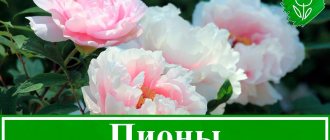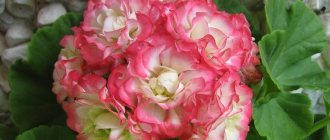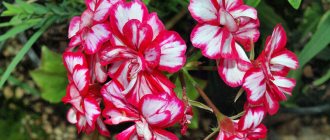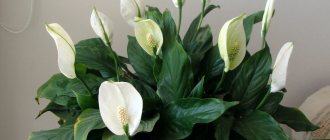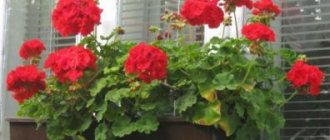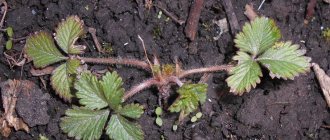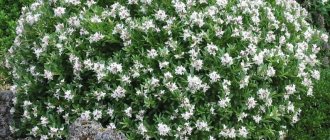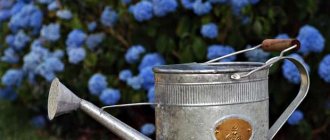Geranium, or, as our grandmothers affectionately called this flower, “kalachik,” is found in almost every home. Dark green, slightly hairy leaves and gorgeous flowers in a variety of shades create a cozy home. There was a time when this flower, along with ficus, was called bourgeois, but, fortunately, these times have sunk into oblivion, and geranium continues to delight us with its flowering.
Among the numerous geranium family there are plants that are completely unpretentious in care; even a beginner in floriculture can cope with their cultivation. But perhaps not everyone knows that among these plants there is a variety that has been awarded the title of royal. This flower can hardly be called just a geranium; many inexperienced flower growers will not find any similarity between it and their cute and more modest flower on the windowsill. And of course, it’s unlikely that anyone would call him a “kalachik.”
The heroine of our article will be the luxurious royal indoor geranium. This is a complex plant that requires constant attention and careful care. But we assure you, your efforts will be richly rewarded when you see the royal geranium bloom.
Features of flowering
It is not for nothing that geraniums with large (simple or double) flowers are given royal status. Seeing flowers of all shapes and colors collected in umbrellas, it is impossible to pass by. Royal varieties do not bloom as long and require more care.
They reach a height of 30 to 70 cm and differ from other species:
- voluminous, up to 7-8 cm in diameter, flowers;
- corrugated leaves with a rough surface and jagged edges.
Important. The royal type of geranium is the most capricious; if you do not water regularly, you will never be able to wait for flowering.
Care for geraniums - tips
Despite the fact that pelargonium is an undemanding indoor flower, it nevertheless requires proper care. For full growth and abundant flowering, it will need good lighting, regular watering and frequent loosening of the soil. In addition to this, basic plant care includes fertilizing and removing faded buds and leaves. In order to get healthy and beautiful flowers, young bushes are pinched at the stage of appearance of several leaves. In order to get a densely branching bush, the plant is planted in a large pot. In small pots, geranium will delight you with rich flowering. Pelargonium, like many other indoor plants, is sold in pots filled with a soil substitute. It is not recommended to immediately replant a purchased flower in a new soil mixture. He will need 2-3 weeks to adapt.
The transplanted flowers are sprinkled with soil, without compacting them, watered a little. At first, the flowers are not fed.
Geranium is unpretentious to soil
When planting, it is extremely important to place a layer of drainage at the bottom of the pot. This will prevent rotting of the root system and stagnation of water at the bottom
Neutral and slightly alkaline soil is perfect for the growth of pelargonium. If you add a little ash to the soil, this will reduce its acidity. Leaf and turf soil mixed with sand and humus in equal proportions is an impeccable soil mixture for pelargoniums.
Proper care of flowers during the growing season is very important. It is not recommended to fertilize these flowers with organic fertilizers. Overfeeding can cause severe burns to plants. What they need is mineral fertilizers. They are rich in potassium, phosphorus and contain a very small percentage of nitrogen.
Pelargonium needs frequent and moderate watering. Before each moistening, the top layer of soil must dry out. In the cold season, flowers are watered no more than once every three days, in the summer - daily.
It is important to know that geranium cannot be sprayed. To increase air humidity in the room, place trays of water
Royal geranium tolerates dry air much worse than other varieties of pelargonium. This variety requires special care.
A well-lit place is the key to active growth and abundant flowering of geraniums. Lack of lighting can lead to houseplant disease, as well as a decrease in the number of flower buds.
In summer, when it’s hot, the flower should be placed in a shaded place to prevent the leaves from getting sunburn. South-facing window sills are an ideal place for growing geraniums.
With the onset of summer, pelargonium is planted in the garden in open ground, where it can delight with its decorative appearance and bright colors all season long. The main thing is to provide her with the proper conditions of detention and proper care. Geranium does not tolerate wind or drafts. In addition, an indoor flower planted in the shade will have small, faded leaves and is unlikely to bloom.
Photo
In the photo you can see what beautiful and lush flowers of royal geranium look like.
Transfer rules
Royal geranium has a very unfavorable attitude towards various movements. Transplantation is carried out in exceptional cases. It is better not to disturb the plant at all. But it happens that you still have to seat them. For example, there may be cases in which the root system has grown so intensely that it simply no longer fits into the pot. In this case, of course, the plant must be replanted.
Transplantation is recommended every 2 years. If this requirement is not met, the plant may stop flowering or there will be a small number of flowers. The optimal time for transplantation is the very beginning of February. The soil should be prepared, which will consist of peat, deciduous soil, turf soil and river sand. Good drainage is essential. Expanded clay or river sand are best suited for this purpose.
How to help the plant?
When the ovary appears, it is important to eliminate obstacles to the formation of inflorescences:
- Flowers in direct sunlight will not be bright.
- In winter, the plant benefits from coolness, but temperatures below 10 degrees will not do any good and will stimulate the plant to awaken prematurely from hibernation.
- A southern windowsill, where there is a lot of sun, is the best place for geraniums.
- For lush flowering all year round, the prerequisites are nutrition and lighting.
- Lots of branches - lots of room for flowering. To enhance branching, shoots are pinched.
- Fading flowers are immediately removed.
- With regular pruning, geraniums rejuvenate and gain strength for growth.
- Geranium grown from seeds blooms four to five months after sowing. During this time, the plant gains vegetative mass.
Necessary conditions for lush flowers
For beautiful, lush flowering, the gardener must comply with several conditions:
Lighting. Plants prefer diffused light, otherwise the leaves turn red or yellow; if there is not enough sunlight, there will be no flowering.- Temperature. In winter, the plant needs 13 degrees, otherwise the stems become bare and the foliage falls off. In summer, the temperature is maintained at 18-20 degrees and the pots are shaded. You can plant it on the balcony or take the pot out into the front garden for fresh air.
- Humidity. Maintain soil moisture; spraying foliage is prohibited.
- Fertilizer. In the spring, fertilize twice a month; in the summer, once is enough. When growing indoors, organic fertilizers are not used; phosphorus, nitrogen and potassium are added in equal parts. Do not fertilize in winter or during extreme heat.
Reproduction methods
How to propagate geranium? Royal pelargonium is mainly propagated by cuttings. Seeds are used only from store-bought ones. The seeds collected from your plant will sprout, but the flowers will be smaller in size and will lose their characteristic bright color.
Cuttings
Description. To avoid further injury to the plant, cuttings are combined with pruning. Use cut tops with three pairs of leaves. It will not be possible to root royal pelargonium in water - the base of the cutting will rot. Therefore, they are planted directly in the ground.
Procedure
- Before planting, the base of the cuttings is dipped in charcoal powder and dried for several hours.
- Deepen into loose substrate. A mixture of equal amounts of sand and perlite or peat and sand is suitable. In order not to disturb the roots again, it is better to immediately take separate cups. According to some gardeners, it is convenient to use peat tablets.
- After rooting, the cuttings are carefully transplanted into larger diameter pots with nutritious soil. It is better not to rush, to carry out the first transplant in a couple of months.
- Pinch over the third pair of leaves, and repeat pinching as it grows.
The seedlings are watered twice a month with complex fertilizers with a minimum content of nitrogenous substances. Its concentration in the composition should not exceed 10-11%. The first flowering after rooting of the cutting occurs after six to nine months.
Seeds
Description. Growing from seeds is used as a way to simultaneously produce a large number of young plants. Only store-bought seeds are used.
Procedure
- Sowing begins towards the end of winter. Seeds are sown in a light, loose substrate under cover.
- Keep in good lighting, if necessary, supplemented with fluorescent lamps.
- Check the humidity of the substrate daily and remove condensation from the film or glass.
Shoots appear quite quickly - in about two weeks. The germination rate depends on the level of lighting, temperature, and time of seed collection. Fresh seeds germinate much faster. Seedlings can be planted after three or four true leaves appear.
How to make it produce buds?
If all conditions are met, geranium does not bloom, then radical measures will help. Here's what to do:
- Trimming excess shoots and dried leaves promotes the growth of new buds of future inflorescences.
- Moving a pot of geraniums to a sunny windowsill.
- A prerequisite is maintaining peace. To do this, remove the pots from bright light and provide a temperature of 13-14⁰C.
- As the weather warms up, plant pots are placed on the balcony or in the garden to stimulate flowering.
- In the spring, a weak solution of iodine is used to water pelargonium, avoiding contact with the stems and leaves.
- Replace the top layer of soil with a mixture of humus, peat and sand.
Attention. When the soil dries out, the roots rupture, and from excessive watering, rot begins.
Royal geranium does not bloom: what to do?
This question worries many gardeners. There may be several reasons for this. To understand them, you need to understand what royal geranium needs. Caring for this plant at home involves choosing the right container for planting, the right soil, timely watering and pruning, ensuring a winter dormancy period, and replanting if necessary.
Let's take a closer look at the reasons why geraniums refuse to bloom. If the plant is planted in a pot that is too large, pelargonium begins to actively increase green mass and grow. In this situation, the plant simply does not have enough strength to flower, since its energy is spent on the growth of the root system and landscaping. Replant the flower in a smaller vase.
Another reason is that the roots of the flower are damaged. You should know that royal geranium is susceptible to fungal and bacterial infections of the root system. It is not easy to immediately identify the disease. This becomes visible when the disease affects the stems and leaves. Geranium suffers from a lack of nutrients. In this case, the plant is treated with antiseptics, which are sold in all flower shops. However, if the disease is advanced, it is rarely possible to save the plant. Flower growers should know that any disease and pests (aphids, weevils, mites, etc.) force the plant to spend all its energy fighting them. Flowering in such a situation is out of the question.
Another fairly common reason is the absence of a resting phase. What should you do in this case? Reduce watering in the autumn-winter period, do not feed the flower. Move the plant to a cooler place (for example, to a loggia). Heat in winter is detrimental to royal geraniums. Watering also affects the flowering of the plant, although not as much as the above reasons. What kind of watering geranium requires and why proper pruning is very important for it, we will tell you below.
Plant nutrition
The flower needs abundant watering, but in addition to watering, it is important to feed the “ball”. How can you feed the plant so that it pleases you with flowers? For abundant flowering in the garden, geraniums are watered with fermented mullein.
On the balcony and windowsill, to stimulate flowering, the plant is watered with water with the addition of iodine. Dissolve one drop of iodine in one liter of water and water the plant with 50 grams of iodine water along the walls of the flowerpot. Before fertilizing with iodine, water the flower abundantly so as not to burn the roots. This procedure is carried out once a month.
As a fertilizer for geranium, you can use other products purchased at the pharmacy. In addition to iodine, flower growers use vitamins B1, B6, B12. This is an inexpensive folk method.
With the beginning of spring, geranium needs nitrogen. For summer, vitamins are used - one ampoule per 2 liters of warm water. The soil is watered generously with the solution. After 3 weeks, vitamins are changed. This fertilizer will help royal geranium, but you should not overdo it with fertilizing, as this can destroy the plant.
Organic fertilizers should be used with caution. For lush color, water with well-fermented cow manure (per 10 liters of water - 1 liter of manure), bird droppings (per 20 liters - 1 liter). Fresh manure can destroy the plant.
When choosing between mullein and chicken droppings, it is better to use the first option. For lush flowering, minerals are needed, so organic matter is rarely used.
What problems may arise during the operation?
Royal pelargonium is a delicate flower; the following problems may arise during its propagation:
- The cuttings do not take root - this is a specific feature of the geranium variety. There are types of geraniums that do not produce roots. In this case, try to root the cutting in the soil. Some pelargoniums take one to two months to take root.
- The cutting was cut incorrectly. It must have at least two leaf nodes, or a heel and a leaf node with a bud.
- The stem has rotted. It is necessary to change the water and add activated carbon to it.
- The root growth site is located above the water. You need to monitor the water level; you can leave one bud above it.
- Insufficient soil moisture. The plant should be irrigated on time.
- The cutting was planted incorrectly. It must be deepened, leaving a growth point on the surface. After this, the possibility of roots appearing will increase.
- Geranium seeds are too deep. You should sow the seeds again, deepen them into the soil to a maximum of 3-4 mm.
- Poor quality seeds. Buy and sow seeds from a different manufacturer or from a different batch.
- Incorrect care. The seedlings should not be kept under a lid or film, the soil should be moist and loose, and should not be flooded.
- The soil is infected with blackleg. Before sowing, the soil should be disinfected, the seedlings should be regularly ventilated, and the soil should be sprinkled with ash. When infection occurs, diseased plants are removed, the soil is watered with a solution of potassium permanganate, and sprinkled with crushed charcoal.
- Lack of light. Seeds should be sown in March; early sowing requires illumination. Keep the plants on a bright window, turn the other side to the window glass every day.
It is recommended to plant new geraniums in disinfected soil and follow the watering order.
Pruning and replanting at home
For lush flowering of royal geraniums, it is better to prune in autumn or winter . Improper pruning will lead to loss of attractiveness of the bush and stretching of the stems. We'll tell you how to prune your geranium so that it blooms well:
It is important to take into account the genetic characteristics of royal geranium varieties; it should be bushy and low.- For pruning, use a sharp sterile knife, blade, or pruning shears.
- Pinching at the level of the leaf node is carried out with clean hands.
- The sections are treated with charcoal or ground cinnamon.
- All stems growing inside the bush are removed.
Procedure
There is a certain pruning order that should be followed:
- Remove faded inflorescences, wilted stems, and dried leaves.
- Trim shoots to create a beautiful crown.
- Remove bare stems completely down to the bottom node.
- Leave 2/3 of the stem for wintering, cut off the rest.
Winter pruning
Fans of the “roll” note that the royal varieties stretch out in winter due to a lack of sunlight , therefore:
- Long, bare shoots are cut off; if there are none, the crown is pinched.
- From mid-spring, plants throw out buds, so pruning is stopped from mid-March. To preserve the shape of the bush, the plant is pinched in the summer, after the flowers have withered.
Attention. From December to February it is not recommended to prune geraniums and disturb the dormancy of the plant. During the rest period, a minimum of watering, coolness up to 15 degrees and good lighting are required.
Autumn pruning
Experienced flower growers know that royal geranium is very responsive to proper bush formation. Pruning for lush flowering is most often done immediately after the pelargonium has faded. This usually happens at the end of August. This procedure should be carried out in two stages with an interval of 1.5 months. This is necessary in order to prevent severe stress to the plant.
With such early autumn pruning, the royal geranium grows new shoots very quickly. Pinching them (above the fourth pair of leaves) stimulates the formation of new young shoots.
Errors in care and illness
Why doesn’t your favorite geranium bloom at home, but only produce foliage? The main reason is various errors in care. A problem may be uniform watering throughout the year. During active growth, water rarely , but a lot, and do not allow water to stagnate. In winter, lightly moisten the soil so that it has time to dry out between waterings. Fertilizers are used carefully; geraniums suffer from lack and excess nutrition. Balance is important.
Blooming royal geranium needs fresh air and constant ventilation of the room. Fresh air is a prevention against fungal diseases.
The plant is not capricious, but is susceptible to two groups of diseases - non-infectious and infectious:
- If the rules of care are violated, non-infectious diseases appear, the metabolic processes of the plant are disrupted: swelling, hypothermia, lack or excess of microelements, reaction to chemical elements.
- Infectious diseases - rot, infection by virus, fungus, rust, black leg, powdery mildew. They are dangerous because they can be transmitted and infect other flowers. such a plant must be isolated and treated.
The important nuances and rules for propagating royal geraniums by seeds and cuttings, as well as possible problems, are described in a separate material.
Royal geranium is a very beautiful plant. Doesn't get sick often, requires attention 15 minutes a week. If care does not meet the needs of the plant, geranium will quickly signal problems. With careful care, the flower will delight the owner with lush and lush flowering in the spring and summer.
Description
Royal geranium, or royal pelargonium, is a representative of the numerous genus Pelargonium, which has more than 250 species. This is a magnificent indoor flower, which, with proper care, pleases its owners with huge (15 cm) flowers of extraordinary beauty of various colors.
It is native to the humid and hot climate of South America. It thrives in conditions of high air humidity and does not tolerate direct sunlight. At home, royal pelargonium grows up to 60-80 cm. It makes no sense to grow a taller plant, since the buds are only at the apical growth points. At a height of 100 centimeters, the plant completely loses its decorative properties.
Today, many gardeners are interested in royal geranium. Caring for such a magnificent plant at home has many pitfalls that must be avoided in order for the capricious beauty to please with its flowering. It must be remembered that even with full compliance with all the rules of agricultural technology, it is impossible to extend the flowering period of royal geraniums. It is significantly shorter than that of ordinary species.
How to prune pelargonium in spring
Pruning geraniums in spring differs from autumn pruning. It is simpler, more gentle, but requires more attention, since the plant restarts life processes in the spring, and at this moment it is easy to harm it.
Purpose and benefits of spring haircut
Spring pruning is necessary to remove weakened and elongated stems. It promotes lush flowering, the growth of fresh green mass and is not produced as deep as the autumn one. It is worth cutting carefully, superficially, otherwise you can delay the flowering of pelargonium for a long time.
Even pruned shoots, rooted in the spring, bloom faster than the radically pruned mother bush.
During the winter, geranium becomes very elongated and often sheds its leaves.
Classic pelargonium (zonal) can turn into a tall, half-naked bush over the winter. This distinguishes it from its dwarf counterparts, who hardly stretch out during the resting period.
Winter pruning of zonal geranium will only harm it, but spring pruning will provoke a massive formation of new buds or the awakening of dormant ones.
Step-by-step instructions for spring pruning
- Haircuts begin no earlier than the end of February, but you shouldn’t wait until mid-March. The sooner you remove excess branches, the faster new buds will form.
After pruning, young shoots will quickly begin to grow
- It is necessary to shorten long, diseased and bare stems, leaving at least 3 buds on each cut shoot.
When forming a geranium bush, leave three buds per shoot. - Branches pruned in spring take root very quickly, so very often spring pruning of geranium is accompanied by its propagation through cuttings.
Cuttings after spring pruning can be used to propagate geraniums
Video: how to prune flowering geraniums correctly
Table: caring for geraniums after spring pruning
| Temperature | An increase in temperature of 3–5°C is allowed (compared to winter). |
| Lighting | Intensive, preferably south window. |
| Watering | A gradual return from moderate winter watering to normal. |
| Top dressing | Spraying with Epin solution (once a week, three times a month). |
| Air humidity | No promotion required. |
Features and benefits of spring pruning of geraniums
Spring pruning of geraniums (pelargonium) involves shortening long, excessively elongated stems. This procedure is aimed at creating a compact and lushly flowering plant. After pruning, the plant takes on a beautiful appearance, becomes stronger and healthier.
Other benefits of pruning:
- an increase in the number of peduncles and the formation of new shoots;
- activation of lateral branching;
- awakening of “sleeping” buds that are not involved in flowering;
- improved air circulation - it flows evenly to all parts of the plant;
- stimulating an increase in flowering duration;
- prevention of many diseases;
- obtaining planting material for propagation.
When pruning geraniums, the following rules should be followed:
- It is forbidden to prune heavily overgrown geranium bushes at one time;
- First, damaged, weakened and strongly retracted shoots are removed;
- after two weeks they begin the second stage of pruning, giving the bush a beautiful and compact shape.
If you prune the entire bush at one time, the plant will direct its energies to restoring the lost greenery, postponing flowering indefinitely.
How to propagate geranium
Seeds
Geranium propagation is carried out in two ways: using seeds and cuttings. The first method is less popular and more applicable for breeding new species of pelargonium. From seeds of a certain variety, plants with completely different decorative qualities can grow.
To plant seeds, take a soil mixture of loose soil, humus and sand. Sowing of planting material is carried out in early spring. For early planting, it is recommended to use artificial light lamps. To prevent diseases, the soil is disinfected before planting and spilled with a weak solution of potassium permanganate (potassium permanganate). The sown seeds must be sprinkled with a thin layer of soil - 2-3 mm. Further care of the seedlings consists of creating greenhouse conditions for their successful germination.
